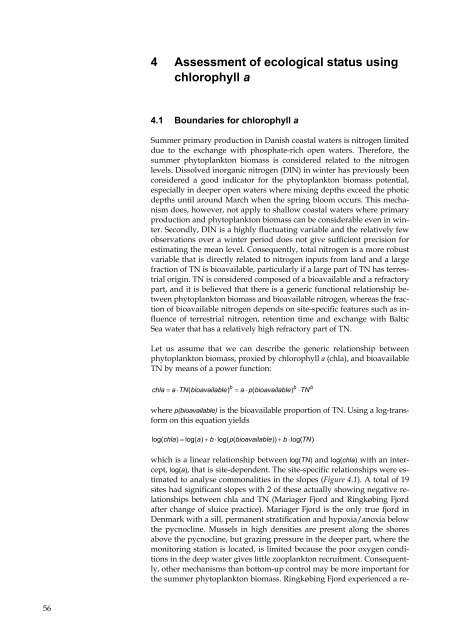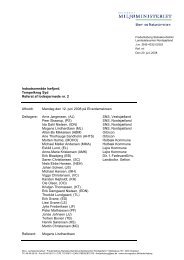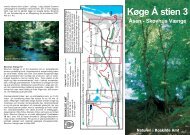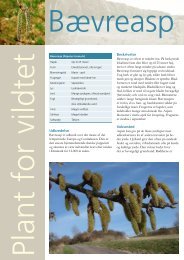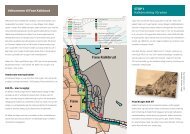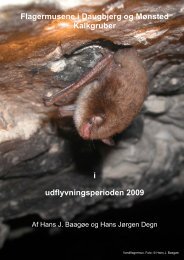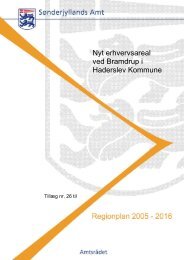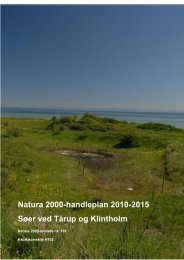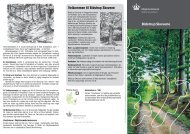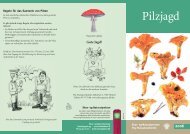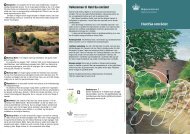Macroalgae and phytoplankton as indicators of ... - Naturstyrelsen
Macroalgae and phytoplankton as indicators of ... - Naturstyrelsen
Macroalgae and phytoplankton as indicators of ... - Naturstyrelsen
You also want an ePaper? Increase the reach of your titles
YUMPU automatically turns print PDFs into web optimized ePapers that Google loves.
4 Assessment <strong>of</strong> ecological status using<br />
chlorophyll a<br />
4.1 Boundaries for chlorophyll a<br />
Summer primary production in Danish co<strong>as</strong>tal waters is nitrogen limited<br />
due to the exchange with phosphate-rich open waters. Therefore, the<br />
summer <strong>phytoplankton</strong> biom<strong>as</strong>s is considered related to the nitrogen<br />
levels. Dissolved inorganic nitrogen (DIN) in winter h<strong>as</strong> previously been<br />
considered a good indicator for the <strong>phytoplankton</strong> biom<strong>as</strong>s potential,<br />
especially in deeper open waters where mixing depths exceed the photic<br />
depths until around March when the spring bloom occurs. This mechanism<br />
does, however, not apply to shallow co<strong>as</strong>tal waters where primary<br />
production <strong>and</strong> <strong>phytoplankton</strong> biom<strong>as</strong>s can be considerable even in winter.<br />
Secondly, DIN is a highly fluctuating variable <strong>and</strong> the relatively few<br />
observations over a winter period does not give sufficient precision for<br />
estimating the mean level. Consequently, total nitrogen is a more robust<br />
variable that is directly related to nitrogen inputs from l<strong>and</strong> <strong>and</strong> a large<br />
fraction <strong>of</strong> TN is bioavailable, particularly if a large part <strong>of</strong> TN h<strong>as</strong> terrestrial<br />
origin. TN is considered composed <strong>of</strong> a bioavailable <strong>and</strong> a refractory<br />
part, <strong>and</strong> it is believed that there is a generic functional relationship between<br />
<strong>phytoplankton</strong> biom<strong>as</strong>s <strong>and</strong> bioavailable nitrogen, where<strong>as</strong> the fraction<br />
<strong>of</strong> bioavailable nitrogen depends on site-specific features such <strong>as</strong> influence<br />
<strong>of</strong> terrestrial nitrogen, retention time <strong>and</strong> exchange with Baltic<br />
Sea water that h<strong>as</strong> a relatively high refractory part <strong>of</strong> TN.<br />
Let us <strong>as</strong>sume that we can describe the generic relationship between<br />
<strong>phytoplankton</strong> biom<strong>as</strong>s, proxied by chlorophyll a (chla), <strong>and</strong> bioavailable<br />
TN by means <strong>of</strong> a power function:<br />
chla = a ⋅TN(<br />
bioavailable)<br />
= a ⋅ p(<br />
bioavailable)<br />
b<br />
b<br />
⋅TN<br />
b<br />
where p(bioavailable) is the bioavailable proportion <strong>of</strong> TN. Using a log-transform<br />
on this equation yields<br />
log( chla)<br />
= log( a)<br />
+ b ⋅ log( p(<br />
bioavailable))<br />
+ b ⋅ log( TN)<br />
which is a linear relationship between log(TN) <strong>and</strong> log(chla) with an intercept,<br />
log(a), that is site-dependent. The site-specific relationships were estimated<br />
to analyse commonalities in the slopes (Figure 4.1). A total <strong>of</strong> 19<br />
sites had significant slopes with 2 <strong>of</strong> these actually showing negative relationships<br />
between chla <strong>and</strong> TN (Mariager Fjord <strong>and</strong> Ringkøbing Fjord<br />
after change <strong>of</strong> sluice practice). Mariager Fjord is the only true fjord in<br />
Denmark with a sill, permanent stratification <strong>and</strong> hypoxia/anoxia below<br />
the pycnocline. Mussels in high densities are present along the shores<br />
above the pycnocline, but grazing pressure in the deeper part, where the<br />
monitoring station is located, is limited because the poor oxygen conditions<br />
in the deep water gives little zooplankton recruitment. Consequently,<br />
other mechanisms than bottom-up control may be more important for<br />
the summer <strong>phytoplankton</strong> biom<strong>as</strong>s. Ringkøbing Fjord experienced a re-<br />
56


